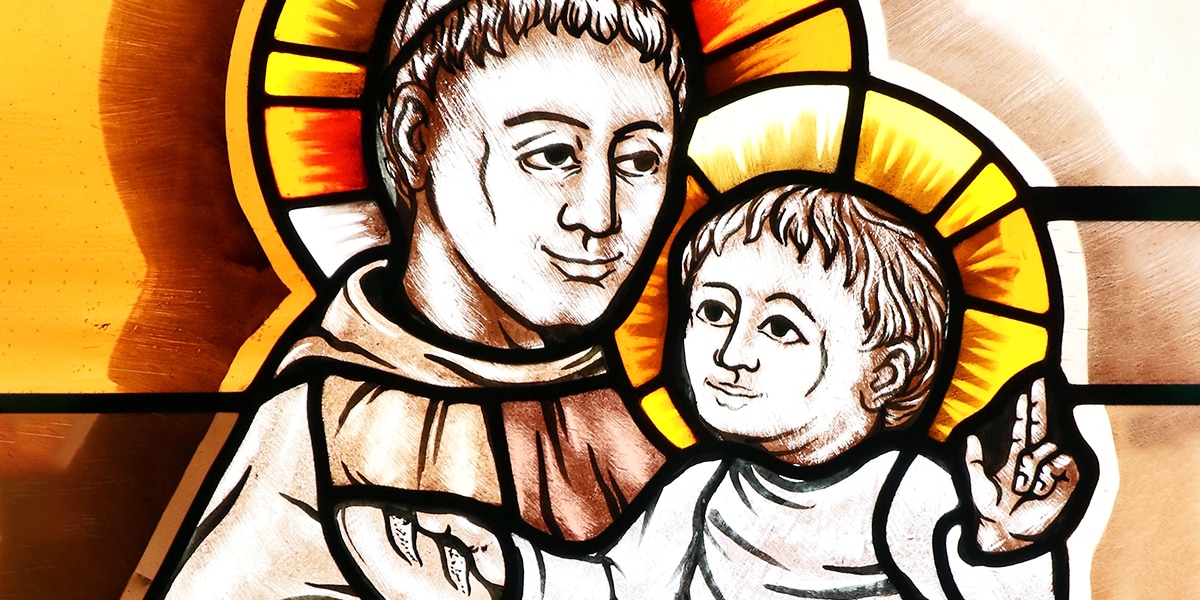In the Basque region of Spain, St. Anthony of Padua is called Santo Casamentero, or the Holy Matchmaker. In 1668, when he had already been dead four hundred years, the Spanish government by royal order made him a soldier in its second infantry regiment. With each victory that regiment shared in, Anthony was promoted in rank. He was finally retired after reaching general in 1889. In many European countries, Anthony is the patron of sailors and fishermen. Everywhere his intercession is invoked for the return of lost and stolen things.
He is also regarded as a patron of priests and travelers, a protector against the devil, and a guardian of the mails. He is called the wonderworker and saint of the world. The story and tradition of devotion to St. Anthony of Padua began almost with the moment of his death on June 13, 1231. His Franciscan brothers tried to keep his death secret to avoid violence and a struggle between citizens of Padua and Capodi Porte to claim his body for burial. Despite their efforts, children began running through the streets of Padua shouting, “The saint is dead!” Crowds came to view the body of Anthony and attend his burial.
His grave at once became a place of extraordinary devotion and numerous miracles. Legends would later attribute to him miracles worked even during his life.
Less than a month after his death the bishop, clergy, nobles and podesta (mayor) of Padua requested his canonization. They gave among their reasons the great veneration and miracles taking place at his tomb. Anthony was not yet dead a year when Pope Gregory IX declared him a saint of the Church, and construction began on a basilica to honor his memory and remains. A papal bull dated two days before the first anniversary of his death granted an indulgence of one year to all who would visit Anthony’s tomb on his feast or within its octave.
Since then, popular piety and devotion to St. Anthony have taken many forms. In some cases, history offers a reason for a particular practice or form of devotion. In other cases, it explained by legend.
And in some instances, the origin of the devotion may be lost or unexplained.
Finder of Lost or Stolen Things
Nearly everywhere, Anthony is asked to intercede with God for the return of things lost or stolen. Those who feel very familiar with him might pray, “Tony, Tony, turn around. Something’s lost and must be found.”
The reason for invoking St. Anthony’s help in finding lost or stolen things is traced back to an incident in his own life. As the story goes, he had a book of psalms that was highly important to him. Besides the value of any book before the invention of printing, the psalter had the notes and comments he had made to use in teaching students in his Franciscan Order.
A novice who had already grown tired of living religious life decided to depart the community. Besides going AWOL, he also took Anthony’s psalter! On realizing his psalter was missing, Anthony prayed that it would be found or returned to him. After his prayer the thieving novice was moved to return the psalter to him and to also return to the Order, which accepted him back.
Legend has embroidered this story a bit. The legend goes that the novice was stopped in his flight by a horrible devil brandishing an ax and threatening to trample him underfoot if he did not immediately return the book. Obviously a devil would hardly command anyone to do something good. But the core of the story would seem to be true. And the stolen book is said to be preserved in the Franciscan friary in Bologna.
In any event, shortly after his death people began praying through Anthony to find or recover lost and stolen articles. And the “Responsory of St. Anthony,” composed by his contemporary, Julian of Spires, o.f.m., proclaims that “the sea obeys and fetters break / And lifeless limbs thou dost restore / While treasures lost are found again / When young or old thine aid implore.”
The Novena to St. Anthony
In many churches and at shrines the world over, it is common to find not only a statue of St. Anthony but also the existence of a continuing novena in honor of the saint. People drop in and out of the devotions, making novenas on nine or thirteen Tuesdays or Sundays. An obvious reason for Tuesday is that Anthony was buried on a Tuesday and that is when the miracles began.
The novena in honor of St. Anthony, according to one or more novena books and leaflets, is linked with a legend about a pious childless couple in Bologna around the year 1617. The story says has it that, after twenty-two years of longing for a child, the wife took her troubles to St. Anthony. He is said to have appeared to her in a dream, telling her, “For nine Tuesdays, one after the other, make visits to the church of my Order; on each of those days approach the holy sacraments of penance and of the altar, then pray before my picture, and what you ask, you shall obtain.”
In one version of the story she conceived but gave birth to a badly deformed child. Again asking the saint’s intercession, she took the child, at Anthony’s instruction, to his altar, and the deformity at once disappeared.
Whatever fact may or may not be behind the legend, in 1898, Pope Leo XIII granted a plenary indulgence to those spending some time in devout meditation, prayers, or the performance of some other acts of piety in honor of St. Anthony of Padua on Tuesday or Sunday of any week with the intention of doing so for thirteen Tuesdays or Sundays without interruption. At the same time, Pope Leo XIII recommended the practice of St. Anthony bread.
St. Anthony Bread
Different legends or stories account for the donation of what is called St. Anthony bread. By at least one account it goes back to 1263, when it is said a child drowned near the Basilica of St. Anthony, which was still being built. His mother promised that if the child was restored to her she would give for the poor an amount of corn equal to the child’s weight. Her prayer and promise were rewarded with the boy’s return to life.
Another reason for the practice is traced back to a baker in France during 1890. Faced with a broken lock on the shop door, the baker prayed through St. Anthony that the locksmith could open the door without breaking it down. She promised bread for the poor in return for her favor. The door was opened, and she kept her promise.
Today St. Anthony bread is the offering or donation given to the poor in honor of St. Anthony for a favor received through his intercession. The donation could also go to a variety of charitable causes. In some places parents also make a gift for the poor after placing a newborn child under the protection of St. Anthony. It is a practice in some churches to bless small loaves of bread on the feast of St. Anthony and give them to those who want them.
St. Anthony Lilies
In many places lilies are blessed on the feast of St. Anthony and given to those who want them. Some people dry them to preserve them or carry them on their person in a cloth container. The lily is meant to remind the possessor of St. Anthony’s purity and our own need to pray for the grace of purity in times of temptation.
This expression of piety is believed to have its roots in eighteenth-century France following the French Revolution. The Franciscans had been expelled from Corsica and their church abandoned. Yet people came to the church for an annual observance of the feast of St. Anthony on June 13. One year, some months after Anthony’s feast, a man wandered into the church and found lilies from the celebration still fresh.
The custom of blessing lilies is another of those approved by Pope Leo XIII. The prayer of blessing asks for the grace to preserve chastity, peace, and protection against the evil one.
St. Anthony’s Brief
“Behold the Cross of the Lord! Be gone, you enemy powers! The lion of the tribe of Juda, the root of David has conquered! Alleluia!” are words that Pope Sixtus V had inscribed on the obelisk he erected in the quadrangle in front of St. Peter’s Basilica in Rome. They are also words attributed to St. Anthony known as the Brief (or letter) of St. Anthony. Some people carry the words with them, a form of asking for protection against the devil.
The custom of carrying and praying the words comes from the story of a woman in Portugal tempted by the devil and obsessed with thoughts of suicide. As the story is related, she was on her way to drown herself but stopped off at a Franciscan chapel to pray before a statue of St. Anthony. During her prayer she fell asleep and saw St. Anthony, who released her from her disturbed state of mind.
When she woke up she found a letter, or brief, given to her by St. Anthony, with the words quoted above. It has been written that the original letter was preserved with the crown jewels of Portugal. This practice may also be rooted in a story about Anthony’s own struggle with the devil, who was trying to choke him. Anthony, says the early account by a contemporary friar, put the devil to flight by invoking Mary’s help and making the sign of the cross.
Guardian of the Mail
Perhaps you’ve received a letter with the initials S.A.G. written somewhere on the envelope or under the flap or stamp. Or you may even have received a letter with a stamp bearing a picture of St. Anthony with the letters S.A.G. The letters stand for St. Anthony Guide or Guard. Usually the stamp has no more postal value than a Christmas or Easter seal. But in 1931, for the seventh centenary of Anthony’s death, both Italy and Portugal issued postage stamps in his honor.
St. Anthony’s association with the mail is said to have come from an incident in his life. According to a story in Charles Warren Stoddard’s St. Anthony: Wonder-Worker of Padua, Anthony wished to journey to the town of Campo San Pietro, some distance from where he was staying. The purpose of the trip was to rest and reflect.
He dutifully wrote a letter to his superior to ask permission for the trip. But when it came time to give the letter to a messenger, it could not be found. Anthony took it as a sign that he was not to go and put the trip from his mind. Inexplicably, some time later he received an answer from the superior giving permission for the trip.
A further association with the mail goes back to an event that was said to have happened in 1792. One Antonio Dante, so the story goes, journeyed to Lima, Peru, leaving his wife behind in Spain. After his departure she wrote to him many times without receiving any reply. Finally, she went to the church of St. Francis in Oviedo and placed in the hands of St. Anthony’s statue a letter to her husband in Peru. She prayed that Anthony would get the letter to him and obtain a reply.
According to the tale, she returned to the chapel the next day. A letter was still clasped in the hands of the statue. She began scolding St. Anthony for not delivering her letter. The noise she made prompted the sacristan, who said he had tried to get the letter from Anthony’s hands but without success. The wife is then supposed to have reached up and taken the letter from Anthony’s hands quite easily. At the same time, three hundred gold coins spilled from the statue’s sleeve. When the letter was opened, it was not the wife’s letter but a letter from the husband. He said that, not hearing from her for so long, he had thought her dead. But her most recent letter had been delivered by a Franciscan priest.
Holy Matchmaker
Among the Basques St. Anthony is called Santo Casamentero, the Holy Matchmaker or saint of those looking for husbands. According to the Handbook of Christian Feasts and Customs by Rev. Francis X. Weiser, Basque girls make a pilgrimage to his shrine in Durango on Anthony’s feast. They pray that he will help them find “a good boy.”
It may help that the young men are said to make the same journey to the shrine, where, gathered outside the church until the young women are finished with their prayers, they wait to ask them to dance. Weiser speculates that the association with engagement and marriage is inspired by all the statues and pictures of Anthony carrying the infant Jesus in his arms.
St. Anthony and the Child Jesus
St. Anthony has been pictured by artists and sculptors in all kinds of ways. He is depicted with a book in his hands, or with a lily or a torch. He has been painted preaching to fish, holding a monstrance with the Blessed Sacrament in front of a mule, or preaching in the public square or from a nut tree.
But since the seventeenth century we most often find the saint shown with the child Jesus in his arms or even with the child standing on a book the saint holds. A fuller treatment of this popular image of St. Anthony is found in the previous chapter.
The Chaplet of St. Anthony
Curious readers occasionally share descriptions or drawings of a chaplet of thirteen beads with a medal of St. Anthony. They want to know what kind of rosary or crown this may be. The beads are called the Chaplet of St. Anthony. The chaplet is prayed by saying, in each set, an Our Father on the first bead, a Hail Mary on the second, and a Glory Be on the third. The chaplet seems to have had its origin in nineteenth-century Padua.
Patron of Sailors, Travelers, and Fishermen
In Portugal, Italy, France, and Spain, St. Anthony is the patron saint of sailors and fishermen. According to Fr. Weiser, his statue is sometimes placed in a shrine on the ship’s mast. And the sailors sometimes scold him if he doesn’t respond quickly enough to their prayers.
Not only those who travel the seas but also other travelers and vacationers pray that they may be kept safe through Anthony’s intercession. Several stories and legends may account for associating the saint with travelers and sailors. First, there is the very real fact of Anthony’s own travels in preaching the gospel, particularly his journey and mission to preach the gospel in Morocco, a mission cut short by severe illness. But after his recovery and return to Europe, he was a man always on the go, heralding the Good News.
There is also a story of two Franciscan sisters who wished to make a pilgrimage to a shrine of our Lady, but they did not know the way. A young man is supposed to have volunteered to guide them. On
their return from the pilgrimage, one of the sisters announced that it was her patron saint, Anthony, who had guided them. Still another story says that, in 1647, Fr. Erastius Villani of Padua was returning by ship to Italy from Amsterdam. The ship, with its crew and passengers, was caught in a violent storm. All seemed doomed. Fr. Erastius encouraged everyone to pray to St. Anthony.
Then he threw into the heaving seas some pieces of cloth that had touched a relic of St. Anthony. At once, the storm ended, the winds stopped, and the sea became calm.
Teacher, Preacher, Doctor of the Scriptures
Among the Franciscans themselves and in the liturgy of his feast, St. Anthony is celebrated as a teacher and preacher extraordinaire. He was the first teacher in the Franciscan Order to be given the special approval and blessing of St. Francis to instruct his brother Franciscans. His effectiveness in calling people back to the faith through his preaching resulted in the title “Hammer of Heretics.” Just as important were his peacemaking and calls for justice.
In canonizing Anthony in 1232, Pope Gregory IX spoke of him as the “Ark of the Testament” and the “Repository of Holy Scripture.” That explains why St. Anthony is frequently pictured with a burning light or a book of the Scriptures in his hands. In 1946, Pope Pius XII officially declared Anthony a Doctor of the Church. It is in Anthony’s love of the word of God and his prayerful efforts to understand and apply it to the situations of everyday life that the Church especially wants us to imitate St. Anthony. While noting in the prayer of his feast the effectiveness that Anthony is known for as an intercessor, the Church especially wants us to learn from Anthony the teacher the meaning of true wisdom and what it means to become like Jesus, who humbled and emptied himself for our sakes and went about doing good.








